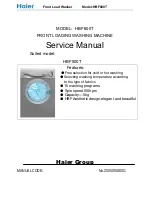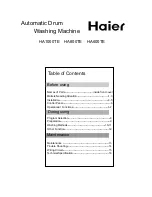
9
Follow Winterizing
Instructions for cold
weather care.
Care and Cleaning
Figure 1
(
Lock tab is visible only after drawer has
been pulled out)
Figure 2
Outside
•
When washing is completed, wipe top and sides of washer with a damp cloth.
Turn water faucets off to prevent pressure build-up in the hoses.
•
As needed, clean the cabinet with mild soap and water.
Never use harsh, gritty
or abrasive cleansers.
If door or console becomes stained, clean with diluted
chlorine bleach [1/2 cup (120 ml) in 1 quart (.95 L) water]. Rinse several times
with clear water.
•
Remove glue residue from tape or labels with a mixture of warm water and mild
detergent. Or, touch residue with the sticky side of the tape or label.
•
Before moving the washer,
place a strip of cardboard or thin fiberboard under
the front leveling legs to prevent floor damage.
Cleaning the Dispenser Drawer Area
Detergent and fabric softener may build up in the dispenser drawer. Residue should
be removed once or twice a month.
•
Remove the drawer by first sliding the safety latch to the right, then pulling the
drawer out until it stops. (Figure 1)
•
Reach back into the left rear corner of the drawer cavity and press down firmly
on the lock tab (left rear portion of the drawer). Pull out the drawer. (Figure 2)
•
Remove the inserts from the bleach and fabric softener compartments. (Figure
3)
•
Rinse the drawer and inserts with hot tap water to remove traces of accumulated
powders and liquids.
•
To clean the drawer opening, use a small brush to clean the recess. Remove
all residue from the upper and lower parts of the recess. (Figure 4)
•
Return the bleach and fabric softener inserts to their proper compartments.
Replace the dispenser drawer and run the Prewash cycle without any wash load
in the drum.
Inside
•
Remove items from the washer as soon as the cycle ends. Excess wrinkling,
color transfer, and odors may develop in items left in the washer.
•
Before cleaning the washer interior,
unplug the electrical power cord
to avoid
electrical shock hazards.
•
Dry around the washer door opening, flexible gasket, and door glass. These
areas should always be clean to ensure a water tight seal.
•
When extremely soiled items have been washed, a dirty residue may remain
on the drum. Remove this by wiping the drum with a nonabrasive household
cleanser. Rinse thoroughly with water.
•
The plastic drum vanes may become stained from fabric dye. Clean these parts
with a nonabrasive household cleanser. This prevents dye transfer to future
loads.
Winterizing Instructions
If the washer is stored in an area where freezing can occur or moved in freezing
temperatures, follow these winterizing instructions to prevent damage to the
washer:
1.
Turn off water supply faucets.
2.
Disconnect hoses from water supply and drain water from hoses.
3.
Plug electrical cord into a properly grounded electrical outlet.
4.
Add 1 gallon (3.8 L) nontoxic recreational vehicle (RV) antifreeze to empty wash
drum. Close door.
5.
Set cycle selector knob at a spin setting. Pull out knob and let washer spin for
1 minute to drain out all water. Not all of the RV antifreeze will be expelled.
6.
Push in knob, unplug electrical power cord, dry drum interior, and close door.
7.
Remove dispenser drawer. Drain any water in compartments and dry
compartments. Replace drawer.
8.
Store washer in an upright position.
9.
To remove antifreeze from washer after storage, run empty washer through a
complete cycle using detergent.
Do not add wash load.
Figure 3
Figure 4





























